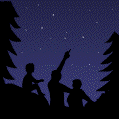 |
Star Chart for North Bend, WA |
 |
|
|
|
| Sun/Moon Data for North Bend, WA: | |||
Sunspot Activity
Space Weather |
Sunset: 8:48pm Sunrise: 5:39am DIY Sunspot Viewer |
|
59% illuminated - Waning Gibbous Moon Moonrise: 11:28pm (26-Jul-2024) New Moon: Sun, 04-Aug-2024 4:14am PDT Full Moon: Sun, 21-Jul-2024 3:18am PDT |
Astronomy Fact
Made up of billions of pieces of ice, the average thickness of each of Saturn's seven giant rings only ranges from about 200 to 3000 meters.

| Color Key |
| Worse | Better | Best | Sky (including Wind) | ||||||||||
| Worse | Best | Worse | Ground |
Space Track-Satellite Passes
Notes about viewing ESVs:
When using lookangles, choose passes with high magnitudes; less than 6.0. ("Looks" are local time.)
Best viewing is when ESV is in Earth's penumbra; on the map, it's the solid line during night.
Dotted line on map denotes ESV is dark, in Earth's umbra (shadow).
Objects in orbit have to maintain a speed of at least 17,500mph, therefore ESVs traverse the sky noticeably different than aircraft.
ESVs appearing to blink are either tumbling rocket bodies, or spinning payloads with deployed solar arrays.
High-Eccentricity objects have a more ellongated orbit. Ground trace looks like a backwards C.
Regression-Ground traces will move West with each orbit due to Earth's rotation.
Script courtesy of: Lee from MadALwx. Page template and Facts script courtesy of: TNET Weather.
Page Template and Moon script courtesy of: Saratoga Weather.












